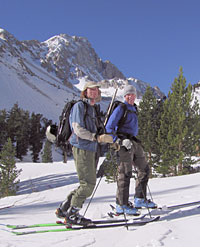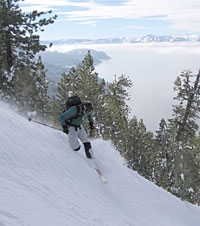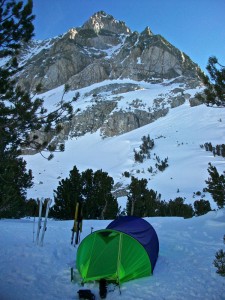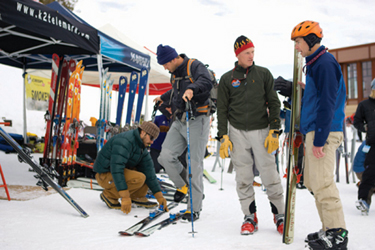- Tahoe’s Nevada Beach Tops the List of Hard-to-Book Campgrounds - 07/17/2024
- Cannabis Watershed Protection Program Cleans Up Illegal Grow Sites - 07/10/2024
- French Fire - 07/05/2024
Text and Photos by Mike Schwartz

Telemark and AT (Alpine Touring) gear are all the rage these days. They’re proliferating at ski areas as fast as in the backcountry. The latest gear is half the weight and twice the performance of what you might expect. With one setup, you can comfortably tour the Sierra backcountry and hit the steeps at Squaw Valley. The choice to drop your knee or not is a tough one. Don’t sweat it if you can’t decide; the skills you develop in one discipline will help you conquer the other should you wish to switch later.
Alpine Touring (AT or Randonnee) refers to downhill ski gear that has a touring mode in which the heel releases for climbing uphill with skins (traction strips for your skis). Although AT gear is designed for the backcountry, most resort skiers will find no performance downgrade in this comfy, ultra-lightweight choice. Who wouldn’t want to cut the weight of their alpine ski gear in half! The boots have curved, lugged, rubber
soles, which help you walk comfortably and confidently in the mountainsor in the parking lot. You’ll feel like driving home wearing them. The bindings have release functions with traditional “DIN” settings and have become quite durable. Not coincidentally, many ski areas are adopting open boundary policies; helping customers hit the neighboring backcountry slopes in the same day.
Most AT gear comes from Europe where the ski areas and backcountry blend together even more. When improved AT products from Fritschi, Scarpa, and Dynafit hit the United States a dozen years ago, the wave began to really grow. The masses finally realized you didn’t have to learn to telemark to explore the backcountry. Today, AT gear can be lighter weight and costs about the same as telemark gear. AT gear sales surpassed telemark gear sales this year in the US. In Europe, AT skiers outnumber telemark skiers by a staggering percentage. The term Alpine Touring says it all. AT gear is for exploring the “alpine” or high mountains. The sport of telemark skiing is just that a type of turn you can make if you want to ignore the evolution of alpine skiing. Telemark gear works great for backcountry skiing as well. But without the desire to master the telemark turn, most ski mountaineering pros usually suggest AT gear.

THE DEBATE:
AT Ski Mountaineer:
Locking your heel in AT gear means you’re less likely to blow a turn where it counts. Most telemark skiers never get real comfortable on steep, firm, or exposed terrain.
Telemark Evangelist:
Most backcountry skiers don’t aim for such terrain anyway. Others master the hybrid parallel turn, and like the versatility of more turning options.
AT Ski Mountaineer:
Skipping the hundreds of lunging knee bends a telemark skier performs means reduced fatigue.
Telemark Evangelist:
Uherso what’s your point?
Actually, parallel turning on tele gear isn’t too tough with typical smooth snow conditions found in the backcountry. Tall boots and fat skis make telemarking a lot easier as well.
AT Ski Mountaineer:
The AT binding pivots more freely at the toe compared to the telemark binding, which drastically improves climbing efficiency. Breaking trail in new snow sucks with telemark bindings, as your shovel dives into the snow. Furthermore, AT bindings are easier to change direction on steep terrain with a practiced “kick turn” you can perform, thanks to the free pivoting binding.
Telemark Evangelist:
Yeahno amount of stretching or Yoga helps you lift your uphill ski above your neck in the switchbacks. There are tricks to make it through extreme skinning situations it’s not impossible. Actually, two new tele options just surfaced this year with a free toe pivot!
AT Ski Mountaineer:
AT ski boots lack the extra “duck bill” at the toe, which allows more purchase when kicking steps uphill.
Telemark Evangelist:
Dude, at the point where I’m nervous standing high on a firm slope, either my crampons or skis are on!
AT Ski Mountaineer:
In the event of a serious fall or an avalanche burial, you’ll be psyched your AT bindings released you out of your skis.
Telemark Evangelist:
There is a viable “DIN” releasable telemark binding that is gaining popularity. On the other hand, it would suck to post hole all night to get home, because your ski accidentally went shooting into the wrong drainage. Unwanted ski release is bad news in a steep couloir as well.
AT Ski Mountaineer:
AT bindings don’t have cables that can snap, or 3-pins to fail.
Telemark Evangelist:
You’ve obviously missed the last 10 years in telemark binding evolution. AT bindings break out there too, but only the telemarkers seem to carry spare parts.
 Knowing all of the AT advantages, I’m still a telemark skier. It’s not because I look cool, because I don’t.
Knowing all of the AT advantages, I’m still a telemark skier. It’s not because I look cool, because I don’t.
It’s not because I’m old school, because I’m not. It’s not because I’ve mastered it; my AT friends sometimes ski by me like I’m standing still. I’ve become addicted to the free-heel feeling when skins are off. I also love the versatility of throwing in any turns I’m in the mood for. Of course, you’ve probably heard tele gear is pretty advanced these days. The free-heeling chargers you see on the steeps at the ski area are often people who have only a season or two under their belts. Boots have gotten taller and stiffer, but weigh less than the old leather boots. They are so supportive that you can learn to make flawless parallel turns in smooth snow conditions. “Paramarking” saves energy and gives the telemark skier freedom to hold an edge more confidently on firm snow. Dropping the knee sometimes gives you back your balance in tricky snow that confuses the AT skier. Still, few actually try to argue that telemark skiing is easier than AT skiing. Okay… no one does.
If you’re still wondering what to do, ask yourself: “Do I usually do things the easy and smart way?” A few years ago, K2 Skis, which produces one of the most popular telemark ski lines, came out with a bumper sticker that reads, “Randonnee… French for can’t tele.” I still haven’t seen a comparable comeback from the fixed-heel crowd.
Mike Schwartz is owner of The BackCountry stores in Truckee and Tahoe City. He encourages people to enjoy the Sierra snowpack no matter what gear they use. More info on AT and tele gear, and where to break trail with them in the Tahoe area, is available on his website, www.thebackcountry.net. You can also check out avalanche and weather conditions, and the latest postings on the Tahoe Backcountry Message Board.













